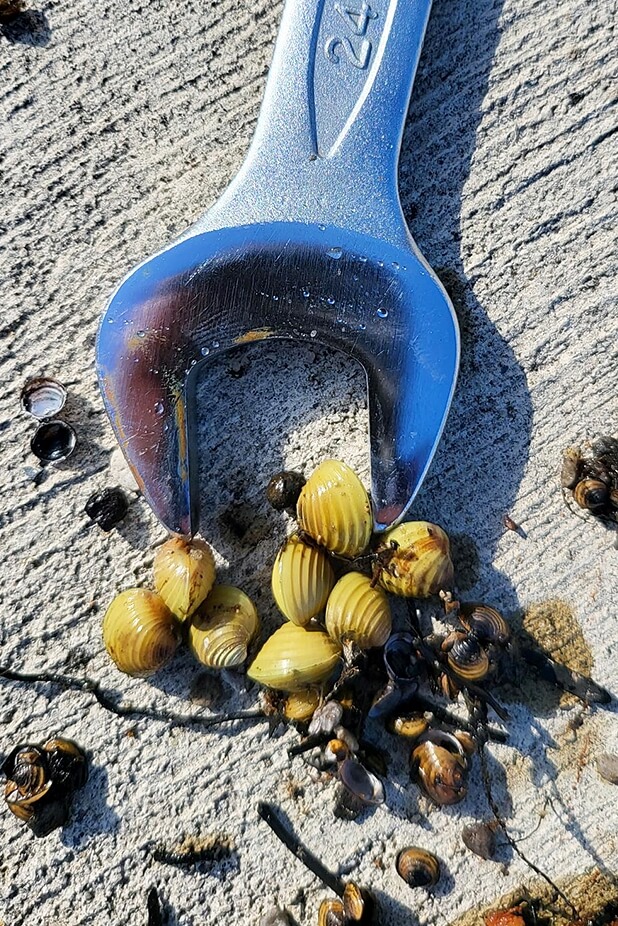A new study has modelled which habitats might be most vulnerable to gold clam infestations – and suggest they are here to stay and finding the country more hospitable because of climate change.

Clams found in Karapiro
It suggests the focus should be on stopping spread rather than eradication.
The tiny pest, which can self-fertilise and lay 70,000 eggs a year, are in a stretch of the Waikato River at Karāpiro.
Corbicula fluminea is a highly invasive freshwater mollusc, which has been restricted to the Waikato since being found last years, but there are fears it will spread and water users have been targeted in a campaign.
The Ministry of Primary Industries was criticised by The News over its communication having become aware the clams were in the Waikato River last year and it was subsequently criticised for a “lack of haste” in not communicating with partners and shareholders with the same urgency seen around the mycoplasma bovis outbreak.

Karāpiro Domain site manager Liz Stolwyk with clams she removed from the boat ramp on Saturday.
Parliament’s Environment Committee suggested it appeared MPI had prematurely eliminated the option of eradication,
The new study’s lead author, University of Otago student Rose Somerville, completed the paper alongside Cawthron Institute freshwater scientists Calum MacNeil and Finnbar Lee while on placement at Cawthron as a summer scholar.
They found the most accommodating habitats in the North Island were in northern Waikato, Auckland, Northland, Bay of Plenty and Hawke’s Bay. In the South Island the most suitable habitats included Marlborough, North Canterbury and Christchurch.
The details of the report were released on Monday.

Clams found at Pukerimu intake
Somerville said there was an urgent need to identify suitable habitats for the species beyond the Waikato, given the high probability of spread.
“Our aim was to use modelling to identify habitats in different parts of Aotearoa New Zealand that would be the most suitable for the gold clam to thrive in by looking at environmental variables associated with the species’ distribution here and in other parts of the world where it lives,” Somerville said.
“We looked at environmental variables such as temperature, slope, elevation, the sand content of the river/lakebed, and the pH of the water.
“The value of using a statistical model is it gives us a bit of a head start on the invasion. By identifying freshwater habitats with similar conditions to those where the gold clam occurs internationally, we can allocate resources to high-risk environments.”

Size of the largest clams
“Worryingly, we found temperature to be a key driver of habitat, with the gold clam preferring warmer waters, suggesting that climate change may result in more of the country becoming suitable habitat for the clam.”
Calum MacNeil, an invasion ecologist at Cawthron Institute, said the gold clam is a major threat to New Zealand’s freshwater ecosystem health.
“Because it’s a recent arrival, the long-term impacts of invasion are yet to be determined, but there’s a lot of evidence to suggest gold clam could outcompete other species including our native freshwater mussel species the Kākahi.”
“Beyond the damage to ecosystems, Gold Clam has also been reported to cause damage to infrastructure by biofouling things like water treatment systems and power plants.”

MPI at Lake Karapiro during the waka ama.
Finnbar Lee said the study suggested the focus should be on preventing the species from gaining a foothold in new habitats.
“Eradication is a very difficult task once the species has established, so we should focus on preventing it from spreading in the first place,” Lee said.
“Our study only considered where the clam is most likely to spread, but another important consideration is how the clam may move between catchments, for example spread via fishing gear, boats or trailers.
“Identifying the potential dispersal pathways between catchments will further inform where management should be targeted.”

Nathan Reymer was urging people to take care not to spread the invasive gold clams found in local waterways.








